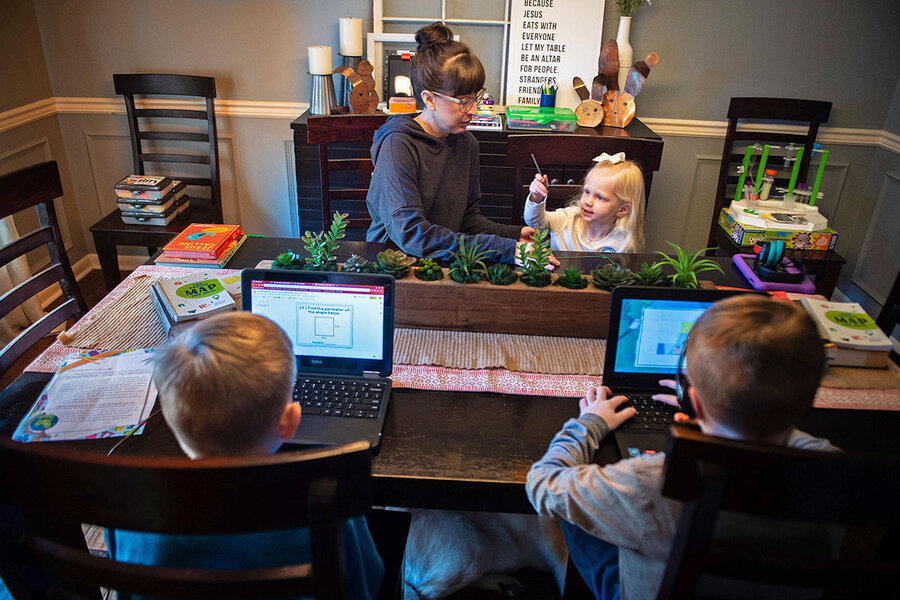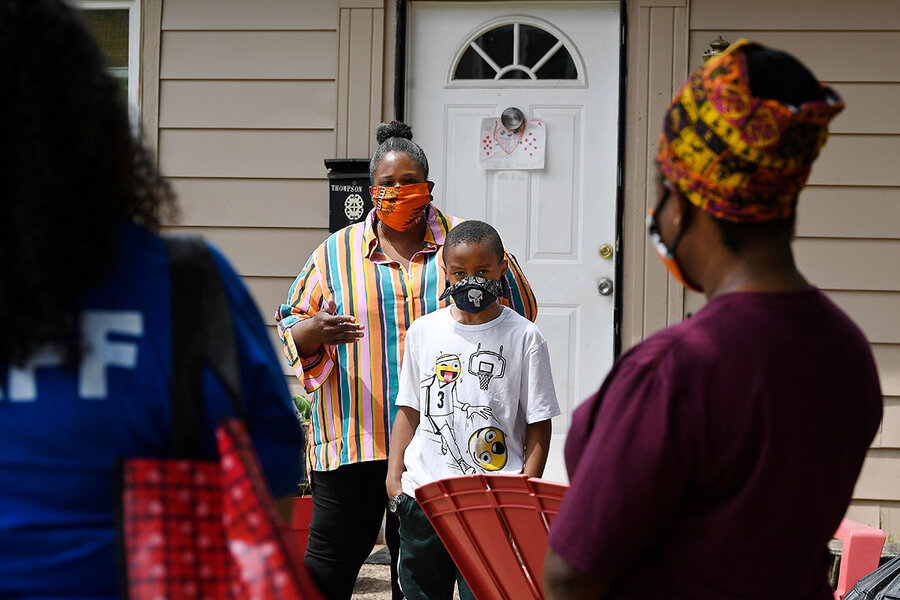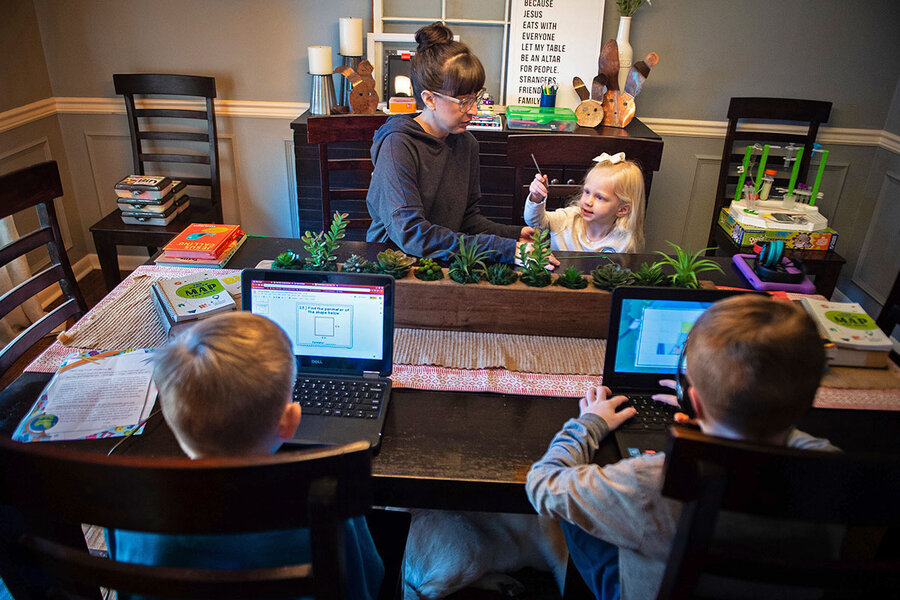
This website uses cookies to improve functionality and performance. By continuing to browse the site you are agreeing to our use of cookies. Close
Why We Wrote This
As the pandemic wears on, how can working parents keep juggling everything? Many are taking a problem-solving approach – carefully thinking through options, tapping into networks, and asking for flexibility at work.
Loading…
Two ways to read the story
They’ve served as teachers, activity planners, housecleaners, and disciplinarians, all while trying to bring in income and without regular support systems. After months of trying to do it all on their own, a number of parents are waving a white flag and asking for help.
These mothers and fathers are looking for arrangements that ease burdens, keep everybody safe, and restore some sense of normalcy. They’re turning to informal networks that include grandparents, friends, and neighbors, and some are looking into professional in-home child care. Many are also asking their workplaces for continued flexible policies.
“[P]arents are tapping into their own ingenuity, resourcefulness, and risk tolerance to create a more sustainable setup for their family,” writes Julia Edelstein of Parents Magazine in an email.
Katie Ring, a commercial photographer from Marblehead, Massachusetts, and her husband recently found child care for their 5- and 6-year-olds. They hired a babysitter whom they share with a family friend, and the children’s grandmother is also helping, after bowing out for several months due to the pandemic.
Says Ms. Ring, “I am so dedicated to continuing on and making it work somehow.”
Overwhelmed by the demands of working from home while caring for three young children, Melody Paine recently asked an online community of mothers running their own businesses for help. Did anyone have creative solutions to share?
Ms. Paine, from Brimfield, Massachusetts, says she struggles with getting interrupted “so many times it takes 1,000 times longer to do anything. … I can’t keep this up much longer.” After reaching out to the online group, she received a burst of support and ideas. She quickly followed advice to contact a local teenager about mother’s helper work and hopes to start an arrangement soon.
“Work is spilling into everything in my life,” says Ms. Paine. “My kids can’t take it, my husband can’t take it, and I’m not taking care of myself.”
Like Ms. Paine, a number of parents are waving a white flag and asking for help after months of trying to do it all on their own. They’ve spent weeks serving as full-time teachers, activity planners, housecleaners, and disciplinarians, all while trying to bring in family income and without regular support systems like school, play dates, and playgrounds.
Editor’s note: As a public service, all our coronavirus coverage is free. No paywall.

For Biden, a VP search fraught with significance
Now, as states gradually reopen, parents are grappling with how to keep their families and communities safe, while giving themselves and their children some sense of normalcy. The steps that are helping them through a still-uncertain time, they say, range from spending more time outdoors to forming backyard summer camps and parent co-ops. Increasingly, parents with the means to do so are expanding their care bubbles, turning to in-home child care, and asking their workplaces for continued flexible policies.
“The pandemic has physically and emotionally exhausted parents of young children, especially working parents,” writes Julia Edelstein, editor-in-chief of Parents Magazine, in an email. “As we enter month five – with no end in sight – parents are tapping into their own ingenuity, resourcefulness, and risk tolerance to create a more sustainable setup for their family.”
Both parents working
Part of the pinch that parents feel comes from the number of families with both parents in the workforce. Last year, 72.3% of U.S. mothers with children under age 18 participated in the labor force, as did 93.4% of fathers with children who were minors, according to the Bureau of Labor Statistics. For mothers with children under 6 years of age, labor participation stood at 66.4%.
Parents with minor children make up almost one-third of the country’s workforce, according to a recent report on working parents and COVID-19 recovery by the Brookings Institution.
Such statistics mean that in most households during the pandemic, there hasn’t been one parent available for full-time child care. Parents laid off or furloughed may be looking for work, or recently rehired. With many restrictions in place on day care centers, summer camps, and schools, parents are turning to informal networks that include grandparents, friends, and neighbors.
“People that already lived close to family and friends are sometimes able to cobble together child care arrangements,” such as having a friend or relative move in or come over regularly, says Jennifer Glass, a sociology professor at the University of Texas at Austin who studies work and families. “They are enlarging their circle, making it a little less of a quarantine, but it’s the only way they can function and still provide income for their household.”
Rafaela Gonzalez and her husband, Anyel Gonzalez, from Lawrence, Massachusetts, both work full time as essential workers, so they rely on family to care for their three children. Keeping the kids inside for so long this spring was stressful, the couple says, and they’ve found recent relief by taking weekend trips to relax outside. Just before the long weekend for the Fourth of July, the family drove to Weirs Beach in Laconia, New Hampshire, where they enjoyed barbecuing and swimming in Lake Winnipesaukee.
Care at home
Professional in-home child care is also increasingly popular. In a recent national survey of parents by Care.com, which matches families and caregivers, 63% of those who use day care are somewhat or very uncomfortable returning their children to day care as states reopen, and more than 35% are considering in-home care instead. Care.com is seeing a “triple-digit percentage uptick” in families seeking in-home child care this summer, according to Chief Marketing Officer Carrie Cronkey.
In addition, “a lot more grandparents are deciding to burst their bubble,” to see or care for their grandchildren, says Madonna Harrington Meyer, a sociology professor at Syracuse University in New York and expert on intensive grandparenting.
Katie Ring, a self-employed commercial photographer from Marblehead, Massachusetts, and her husband found child care recently for their 5- and 6-year-olds. They hired a babysitter whom they share with a trusted family friend, and the children’s grandmother recently started providing care again one day a week, after stopping for several months due to the pandemic.
“It’s like business was closed and now I’ve reopened,” says Ms. Ring, who notes that the families involved and the babysitter all try to keep their social circles small to support each other’s health.
With autumn not far off, President Donald Trump is pressing schools to reopen; Florida has already issued such an order. But many uncertainties remain about schools, only adding to uncertainties regarding child care. Given the state of flux, Ms. Ring has urged her friends to send letters to their legislators supporting two bills introduced in Congress recently: the Child Care Is Essential Act and Child Care Is Infrastructure Act, which have proposed providing $50 billion and $10 billion, respectively, to child care providers for reopening safely. Initial reports estimate almost 4.5 million child care spots may be lost from permanent child care closures due to the pandemic.

Jessica Hill/AP
Parent Titilaya Thompson and her son Nehemiah talk with a school principal and another official seeking to support students in Hartford, Connecticut, on June 5, 2020. Some experts say Black parents carry extra burdens, compared with white parents, during the pandemic.
Workplace flexibility
As parents search for options, there’s some evidence that workplaces will maintain or expand flexible solutions to help employees with caregiving responsibilities.
A May survey by the Society for Human Resource Management found that 86% of organizations were implementing or considering allowing flexible hours for child care needs, and 71% of organizations were implementing or considering allowing full-time remote work for parents with child care needs.
The survey found that employers in knowledge-based industries, such as finance and legal, are more likely to offer flexible work than are those in service- and physical-type industries. Black, Latino, and Indigenous parents are more likely to work in occupations without options for remote work and to lack access to licensed child care, according to the Center for American Progress.
Caroline Walsh, vice president of research in the human resources practice at the research firm Gartner, says the company projects that up to 48% of the U.S. workforce will work remotely at least some of the time post-pandemic, up from 30% pre-pandemic.
“The switch to flexibility may be more acute for parents, but it’s something that organizations are going to need to solve for the workforce as a whole,” since other workers need flexibility for different reasons, such as caring for an ill family member, says Ms. Walsh.
Support online
Another source of support for parents during the lockdowns has been trusted online groups. For example the Black Moms Connection, both a Facebook group and nonprofit, is focusing on how it can serve Black mothers during this time, says Tanya Hayles, BMC’s founder, who is based in Toronto. After receiving an influx of donations during last month’s social justice protests, the group gave small grants to mothers to buy formula or treat themselves to dinner. Ms. Hayles plans to launch a more robust grant program as well as a rental assistance program next month.
The BMC Facebook group has more than 15,000 members. “I’m grateful it exists as a space for Black moms to say, ‘I get it, I know how tired you are, I get it down to my bones how tired you are,’” says Ms. Hayles. “Everyone is going through things from COVID, but the Black community has all these extra burdens and weights to carry and manage.”
The intensity of managing work and family during the pandemic has caused some commentators to advocate for more stay-at-home parents, especially mothers. Writing in Intellectual Takeout, a conservative commentary website, Annie Holmquist asks: “Might all those working mothers discover great beauty in becoming – gasp – a stay-at-home mom?”
“Perhaps families will recognize that the extra income a second job brings is not worth the extra stress it causes mothers,” Ms. Holmquist adds.
Not all parents have the economic option to stay home, says Professor Glass. “We’ve been blithely thinking every mom has someone in the background who can pick up the economic slack, but they don’t,” she says. “We think moms are going to quit, but they can’t afford to.”
Ms. Ring, the photographer, says she’s devoted to maintaining her career while parenting, even during the pandemic, since both are fulfilling to her and are part of her identity.
“I’m an artist. I’m a creative. … Working in my job as a creative, it’s almost self-care; it’s something you can’t turn off,” she says. “There has to be a compromise with caring for my kids and having my career. I am so dedicated to continuing on and making it work somehow.”
Give us your feedback
Give us your feedback
Thank you for contacting The Christian Science Monitor.
